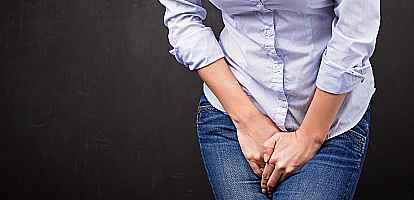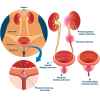Introduction
A Urinary Tract Infection (UTI) is an infection that can occur anywhere in the system that drains or stores urine (urinary tract).
This can be subdivided into the organ involved:
- Bladder - also called cystitis.
- Kidney - also called pyelonephritis.
- Urethra - the tube that drains urine from the bladder. An infection here is also called urethritis.
Other adjacent organs can sometimes get infected when there is a UTI. For example:
- Testicles and epididymis – an infection here is called an epididymo-orchitis.
- Prostate – an infection here is called bacterial prostatitis.
When infection is severe and enters the blood system, this is called sepsis.
Causes of UTIs
UTIs are infections caused by bacteria that enter the bladder from the urethra. In severe cases, these bacteria can ‘ascend’ up into the kidneys causing infections there. Women have a shorter urethra compared to men and bacteria can enter the bladder more easily. Hence, UTIs are more common in women.
What are the risk factors for UTIs?
- Diabetes or other chronic illnesses that compromise the body’s immunity.
- Recent bladder surgery or procedures.
- Advanced age.
- Post-menopausal women.
- Poor bladder emptying (chronic urinary retention).
- Foreign bodies in the bladder (e.g., long-term catheters, retained sutures).
- Immobile patients.
- Kidney stones or bladder stones.
- Poor hygiene (faecal incontinence).
- Pregnancy.
- Recent sexual activity.
- Anatomical abnormalities of the urinary tract.
What are the symptoms?
With bladder infections, the symptoms include:
- Burning in the urine.
- Strong urges to urinate.
- Urinating more frequently.
- Smelly, cloudy or bloody urine (haematuria).
- Low-grade fevers (uncommon).
- Lower abdominal pains.
A bladder infection if not treated properly, can ‘ascend’ up the kidneys. If the kidneys get infected, the symptoms include:
- Flank pain.
- High-grade fevers.
- Night sweats and chills.
- Nausea and vomiting.
- Confusion (especially in the elderly).
- Tiredness, or feeling generally unwell.
What are the investigations?
Urine tests
A midstream, clean-catch urine test is done to diagnose the infection. There are two types of urine tests available.
- Urine dipstick.
- A quick method to screen for infections.
- This can also test for the presence of red blood cells, white blood cells and a chemical called nitrites which are often detectable when there is an infection.
- This will not identify the bacteria.
- Urine culture.
- Most accurate way of diagnosing urine infection.
- A mid-stream urine sample is usually taken.
- The urine is looked at under high-power microscopy to check for bacteria cells.
- It is then incubated in a special medium to isolate and identify the bacteria.
- Special tests are then done to find out which antibiotics will work against those particular bacteria (sensitivity profile).
- Usually takes 3 to 5 days for results to come through.
Blood tests
Blood tests are done in more severe cases of infections.
- The white blood cell count and some inflammatory markers may be elevated during infections.
- A blood culture can also isolate the responsible bacteria.
Radiological imaging studies
Radiological imaging can be very useful, especially in severe cases of infections.
- CT scan of the abdomen.
- Can diagnose kidney infections, stones, abscesses (collection of pus), obstruction or anatomical abnormalities.
- Ultrasound.
- Ultrasound of the kidneys is not as accurate as a CT scan, but it is safe and does not involve any radiation and can pick up most abnormalities.
- Ultrasound of the bladder is usually done at the same time and can give information regarding how well the patient empties the bladder after a void.
- In men, the prostate volume can also be measured and the testicles can also be scanned to check for infection if indicated.
- Kidney nuclear scan
- Useful in assessing how much kidney damage there is from previous infections.
- Can also test for kidney function and obstruction.
- Voiding cystogram
- After some contrast material is infused into the bladder via a small tube, the patient is then asked to void while X-ray pictures are being taken.
- Used to diagnose reflux of urine up the ureter (the tube that drains the kidney to the bladder).
Cystoscopy
Cystoscopy (an inspection of the inside of the bladder with a tubelike camera) is not routinely done, unless in those with recurrent infections or those with more complicated presentations.
Urodynamics
Urodynamics (bladder function test) is usually not performed in most patients. In those who may be suspected to have a bladder dysfunction (e.g., poorly emptying bladder), it may be indicated.
What are the treatments?
Mild to moderate single infections
In mild to moderate cases, a course of oral antibiotics is usually given. This can range from 3 days (in women) to 14 days (in men or in those with medical conditions that compromise their immunity). All patients are encouraged to drink lots of fluids. Pain medications or Ural sachets (powder drinks) may be prescribed to ease some of the pain associated with urination.
Recurrent infections
In those with recurrent mild UTIs, the following options may be considered:
- Non-antibiotic treatments such as D mannose tablets, Hiprex + Vitamin C, and cranberry tablets.
- Daily low-dose antibiotics.
- Single antibiotic dose after sexual activity, in those who commonly get infections after sex.
- Self-start a 3-day course of antibiotics when the patient feels a UTI is coming.
- Oral vaccines can be considered as an adjunct to other treatments.
- Rarely, bladder instillation therapy with a compound consisting of water, calcium chloride, hyaluronic acid and chondroitin sulphate (iAluRil), can be considered. It works by forming a protective lining on the bladder wall.
Severe infections
In severe cases, most patients would need to be hospitalised for antibiotics administered through a drip. Further investigations as detailed above are sometimes indicated. The underlying cause needs to be treated too. Some patients may need surgery, which may range from simply unblocking an obstructed kidney to major surgery such as removal of the kidney.
What steps can I take to prevent an infection?
- Drink lots of fluids (>2L per day).
- Take showers instead of baths.
- Use sanitary pads instead of tampons.
- Cranberry juice or tablets may help.
- Pass urine after sexual activity.
- Avoid tight-fitting pants.
- Wipe from front to back after urinating.
- Ensure proper hygiene in the genital area.

